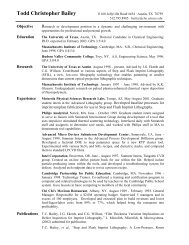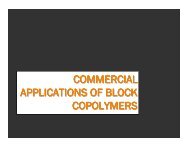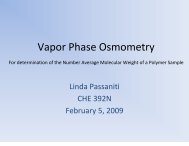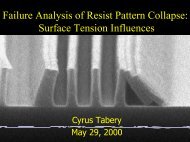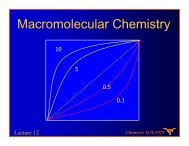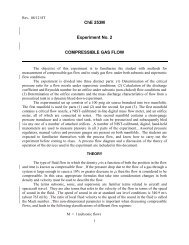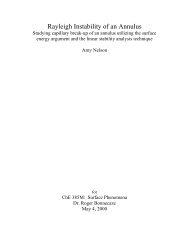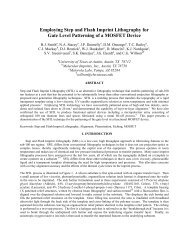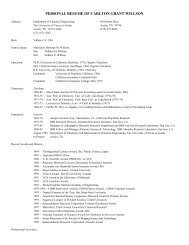Asymmetric fluid-structure dynamics in nanoscale imprint lithography
Asymmetric fluid-structure dynamics in nanoscale imprint lithography
Asymmetric fluid-structure dynamics in nanoscale imprint lithography
- No tags were found...
You also want an ePaper? Increase the reach of your titles
YUMPU automatically turns print PDFs into web optimized ePapers that Google loves.
corrugations on the flow behavior of parallel plate squeeze films have beenstudied from a theoretical and numerical perspective [Freeland 2000]. Freelanddeveloped analytic and numerical solutions for two and three-dimensionalgeometries for flows found <strong>in</strong> both SFIL and nanoimpr<strong>in</strong>t <strong>lithography</strong>. The non<strong>in</strong>ertials<strong>in</strong>kage of a flat, <strong>in</strong>cl<strong>in</strong>ed plate has been thoroughly studied. However,the effect of the asymmetry <strong>in</strong> the pressure distribution across the plate wasneglected <strong>in</strong> comput<strong>in</strong>g the s<strong>in</strong>kage rate [Moore 1964]. Moore proceeded withthe assumption of a pressure distribution, which is a parabola for any sectionperpendicular to the directions spann<strong>in</strong>g the plate. This assumption neglects thecorner effects, but is useful <strong>in</strong> approximat<strong>in</strong>g the three-dimensional pressure dueto a specified load condition. In this thesis, the effect of a non-symmetricpressure variation across a smooth template is treated analytically and applied to anumerical simulation of the equations of motion for the SFIL mach<strong>in</strong>e.In this chapter, the Reynolds equation has been used to study the case ofa squeeze film flow between a flat, quartz template and flat, rigid wafer substrate.First a derivation of the <strong>in</strong>compressible Reynolds equation is given. Next, areduced form of the Reynolds equation is considered. The two-dimensionalReynolds equation can be applied to flow geometries where side leakage can beneglected <strong>in</strong> one of the lateral directions; the squeeze film <strong>in</strong> the y direction canbe considered <strong>in</strong>f<strong>in</strong>ite. The case of an <strong>in</strong>f<strong>in</strong>ite, flat surface that is parallel to asubstrate is presented. This is extended to the case of an <strong>in</strong>f<strong>in</strong>ite, flat surface thatis <strong>in</strong>cl<strong>in</strong>ed relative to a substrate. Apply<strong>in</strong>g specific boundary conditions,analytical solutions for the pressure, force, and torque are obta<strong>in</strong>ed from the twodimensionalReynolds equation.The analytical solutions to the three-dimensional problem (f<strong>in</strong>ite plategeometry) are reviewed as used as a benchmark for compar<strong>in</strong>g the twodimensionalsolutions. The three-dimensional solution for the case of a parallel19



